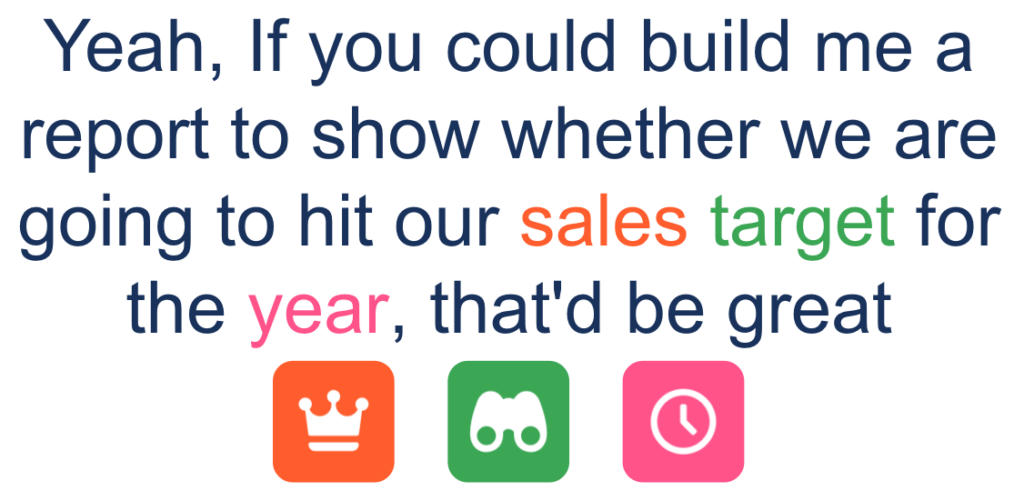Being a data-driven company is more than a buzzword. It is a way of life for businesses, and the benefits it can bring are huge. Your business is likely collecting vast amounts of data, but how can you start using it? It is easy to fall into old habits by building from report requests using gut instinct. However, we often find that this does not yield the expected results.
Handling report requests
If you have ever worked as a Salesforce admin, you have likely received a report request along the lines of “Yeah, if you could build me a report to show whether we are going to hit our sales target for the year, that’d be great”. So, where do we begin?

First, we should break down the requirements to pick out key information. From this sentence, we can see that Sales could be related to Opportunities, Target could be Forecasting Quotas, and this should be within a yearly timeframe.
However, we still need more to go on. It is best to start asking some additional questions.
Asking the right questions?
First, we must understand what to measure, as this can give wildly different results. So, start by asking:
- What records are you reporting on? – Confirm the objects, e.g., Opportunities & quotas
- What are you measuring? – Which fields are to be used? Is it the Amount field, a custom ACV (Annual Contract Value) field, or something else?
- What is the time period? – Are you looking at the current year, a custom year or year to date
- What filters need to be in place? – How do we only focus on the records that matter? For example, filtering only New Business opportunities
Your Audience
Once we understand more about the data we need, we must understand the audience for our requirement, as this will impact the level of granularity of the report and how the data will be visualised. We should do this by checking the following:
- Who will be reviewing the results? – Is this requirement for the leadership team or a sales rep? As a general rule of thumb, senior leaders should only be diving into the details if something does not look right, so starting with a clear indication if things look good or bad will be a top priority.
- How frequently will the report be run? – If the report is to be run daily, the detail is more likely to be greater, vs an annual report
- Are there any similar reports being used? – Often, you will find reports (or Excel spreadsheets) that already exist that a requester is looking to replicate or create a variation of. This is a great starting point where you can change your questioning from ‘What do you need?’ to ‘What needs changing?’.
- Are the audience Salesforce users? – Finally, there is no point in building fantastic reports and dashboards if the audience are not Salesforce users.
Building from what you know
Once you have answers to as many of the above questions as possible, you can start building your report(s)/dashboard. This can then be tested by checking that the expected records appear in the report and the ones that should be excluded are not. Once you have done this, you are ready to present your dashboard to the original requester.

Trusting your data
For certain types of reports, that is our job done, we have reported on what the business has requested, and they can go and happily use it. But what happens when you get asked questions about the quality of that data?
Certain reports require more than the data you have in your system. The data quality may be great, but your reports may need some additional knowledge about the predicted outcomes of your data. For example, consider an opportunity where all the fields are correctly completed, and activities and products are logged against it. But because it is at a certain point in the sales cycle, does that mean it has the same likelihood of closing as all the other deals?
Instead of relying on gut instinct to estimate the likelihood of winning a deal, you can use the data you have collected for years to get more accurate predictions and show evidence for your reasoning.
 Chris TaylorPrincipal Salesforce Consultant
Chris TaylorPrincipal Salesforce Consultant
Looking for help with Analytics?

Looking for help with Analytics?
Becoming Data-driven
In 2006, British mathematician Clive Humby coined the phrase “Data is the new oil.” This statement has become a widely used metaphor highlighting data’s growing importance and value. Similar to oil, data in its raw form is also largely unusable and needs refining to be turned into something useful. Data’s value lies in its potential. Without attention and data preparation, a business cannot start trusting it. Data-driven companies must have enough trust in their data to allow it to be processed automatically. Without this trust, a business cannot use AI tools like Einstein Discovery or Einstein GPT to generate insights. Therefore, they will not trust the output or act on these insights.
This process starts by leading with your data. It involves manually examining your data to find insights, looking at where things can be improved, and building trust in this valuable resource.
Next Step
If you are looking to make that next step and become data-driven, great! You should check out my other post Leading with Data: How CRM Analytics Can Help You Make Better Decisions.
However, if you are still trying to figure things out or need to get your org in top shape, contact our team, who will help guide you through this important journey.


